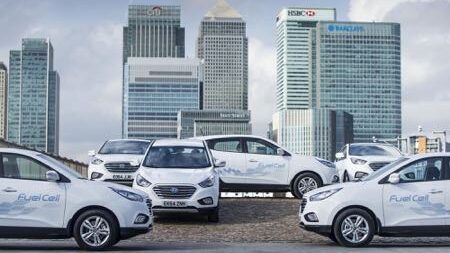When the petrol engine finally conks out in the years to come due to a green lobby insistence, will it be replaced by battery power or hydrogen?
Ask someone in Government what the situation is likely to be they have as much as idea as predicting next week’s lottery numbers.
After talking about it for 10 years the Government has neither the lack of willpower or interest to do anything about it and while manufacturers are happy to put up the investment no one with the reins of power has the guts to make a decision.
Thankfully manufacturers don’t wait for governments and fuel cell development continues apace with Hyundai/Kia; Toyota and Honda are at the forefront in a bid to get their cars on the road.
Hydrogen is a viable fuel alternative to petrol and experts say is probably better than the battery option.
The UK’s first public hydrogen filling station opened in Swindon six years ago in 2011 and is located at car manufacturer Honda’s South Marston plant.
When it opened with great fanfare it was seen as an important step in a UK-wide scheme to make hydrogen vehicles a viable alternative to petrol-driven cars.
But the number of drivers who use it regularly is few and far between while Swindon is among a handful of hydrogen filling operations in the country.
Honda manufactures the FCX Clarity, which was the world’s first commercially available hydrogen-powered vehicle and the company in 2014 opened a solar-powered hydrogen production capable of producing 20 tonnes of hydrogen a year at the Swindon factory. The hydrogen it produces can be dispensed directly into fuel cell vehicles.
Fuel cell cars are still under development and so far have only been manufactured in small volumes, but if made in numbers of 100,000 a year or more, the cost of hydrogen fuel cell cars could already compete on price with a conventional combustion engine-powered car of today.
There are now three FCEVs available for the public to buy – the Hyundai ix35 fuel cell vehicle; the Toyota Mirai and the Honda Clarity.
One of the leading experts in fuel cell development is the Korean engineer Sae Hoon Kim, who works for the Hundai/Kia conglomerate, who has no doubts that the future is a hydrogen one for the motoring industry.
While the Chinese are going down the battery path he points to the fact that it will be virtually impossible to develop a battery for trucks while hydrogen will be a piece of cake.
His fuel cells convert hydrogen for fuel with only water and heat as a green by product and one of his cars has a range of 300 miles between fill ups. No battery can do that.

Two years ago a forecast by the government and industry estimates there should be 65 filling stations in Britain by 2020, concentrated in the busiest parts of the country.
This will make long-distance travel possible on common routes but comprehensive coverage of Britain would require 1,000 filling stations.
Hyundai delivered six of its fuel cell cars to fleets in the UK including Transport for London but this is small beer for the future.
Honda provided hydrogen taxis in London during the Olympics but they had to be brought back to London on transporters at night to be filled up at Swindon for the following day.
The plant will also supply a small fleet of bi-fuel vans belonging to Swindon Borough Council and two fuel cell-powered fork lift trucks working in the production facility.
With Hydrogen producing at the Honda production plant without having to ship it to the site the facility has significant implications for the potential of hydrogen as a transport fuel.
Accounting for around three million litres of a conventional filling station’s capacity and assuming an average car can achieve 35mpg, that’s enough fuel for around 23.1 million miles of motoring.
Honda’s Clarity has a range of 285 miles on 3.9kg of hydrogen, the useable amount in a tank holding 4.2kg.
On that basis, the Honda station could provide enough fuel per year to support more than 1.4 million miles of fuel cell-powered motoring at an estimated pump price for hydrogen of between £5 and £6 per kilogram.
There are less than 20 publicly available hydrogen pumps in the UK making it clear that the hydrogen infrastructure is in it’s infancy when compared to the 5,000+ EV charging point locations in the country.
The hydrogen number of pumps will grow quickly if funding gets the go ahead in the UK and Europe for a hydrogen refuelling network.
But the Government has more things like Brexit and a wafer majority in the House of Commons to worry about than hydrogen so the future is bleak.
Swansea-born and gammar-school educated Sir William Robert Grove developed the two-fluid electric cell or Grove Battery in 1839.

He was refining earlier concepts but essentially it is his work which created the fuel cell to power an electric light in 1842, although it took NASA to bring the power source into the public domain when used on space flights in the 1960s.

